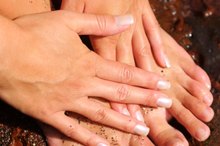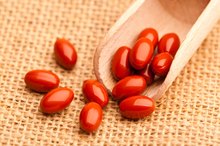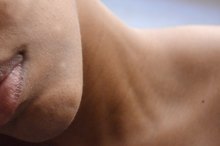Vitamin D & Excessive Sweating
Vitamin D is an essential nutrient that is stored in the liver and is responsible for calcium absorption. Chronically low vitamin D levels can lead to brittle bones in adults and children. Direct sunlight is crucial for natural vitamin D synthesis in the skin. The best time to go outside for the purposes of absorbing the nutrient, according to Joseph Mercola, D.O., is in the summertime between 10 a.m. to 2 p.m., when ultraviolet rays are most intense. It’s also the time of day when you’re most likely to experience excessive sweating.
About Sweat
Excessive perspiration is a natural reaction to your body’s temperature rising above 98.6 degrees Fahrenheit. To stay cool, according to KidsHealth, the brain sends a message to your sweat glands to release a compound consisting mostly of water along with ammonia, urea, salts and sugar. When perspiration is exposed to the air, it evaporates and cools you down. In most cases, sweating is not dangerous. Excessive sweating, however, could be indicative of an underlying problem such as heatstroke or heat exhaustion, which occur after exercising or working in a hot environment, exposure to high temperatures and improper fluid intake. If you’re sweating and also have the chills or feel lightheaded, seek medical attention immediately.
- Excessive perspiration is a natural reaction to your body’s temperature rising above 98.6 degrees Fahrenheit.
- To stay cool, according to KidsHealth, the brain sends a message to your sweat glands to release a compound consisting mostly of water along with ammonia, urea, salts and sugar.
Vitamin D Synthesis
The Effects of Sunlight & Fresh Air on the Body
Learn More
The best way to get vitamin D naturally is through sun exposure. Michael Holick, M.D., a vitamin D expert at Boston University Medical Center, explains that to get your recommended intake of the nutrient you need to go outside in the sun for about 10 to 15 minutes. Other factors, including time of day and year and how much skin is exposed, are also important. According to Harvard Health Publications, except for summer months, people living north of Texas in the U.S. get very little vitamin D from sun exposure. Before 10 a.m. and after 2 p.m., ultraviolet rays are the least intense, meaning that you have to stay outside longer. You also need to expose at least 40 percent of your body, not just your face and hands, according to Mercola. Sitting in the sun for even 10 minutes in the summertime at midday can result in excessive sweating.
- The best way to get vitamin D naturally is through sun exposure.
- Michael Holick, M.D., a vitamin D expert at Boston University Medical Center, explains that to get your recommended intake of the nutrient you need to go outside in the sun for about 10 to 15 minutes.
Considerations
When you go outside and sunlight hits your skin, vitamin D is produced and sits on the surface of the skin. It does not penetrate and get absorbed into the bloodstream right away, Mercola says. It takes about two days -- a full 48 hours -- before your skin will absorb the majority of vitamin D on your skin. While sweating and water from a shower won’t wash away the nutrient, soap can. If you’re going to get your recommended intake of vitamin D from UV rays, avoid washing your arms, legs and torso with soap for two days. Mercola adds, however, that you should still wash your armpits, groin and other areas not exposed to sun.
- When you go outside and sunlight hits your skin, vitamin D is produced and sits on the surface of the skin.
- If you’re going to get your recommended intake of vitamin D from UV rays, avoid washing your arms, legs and torso with soap for two days.
Vitamin D Supplements
Vitamins for Cracked Feet and Heels
Learn More
Many experts, including the Skin Cancer Foundation, discourage direct sunlight on the skin for even 10 minutes, arguing that “all unprotected UV exposure contributes to cumulative skin damage, accelerating aging and increasing our lifetime risk of skin cancer.” Noncarcinogenic alternatives to vitamin D absorption, including supplements and dietary sources, won’t put you at risk for heatstroke or heat exhaustion, either. If you do sweat excessively, Peter Gott, M.D., notes in “Tulsa World,” there’s no evidence that vitamin D -- including excessive vitamin D intake -- is linked to perspiring. It’s possible that your sweating could be a sign of a separate, underlying condition.
Related Articles
References
- The Center for Development; Vitamin D, Joseph Mercola, D.O.
- Alternative Therapies; Michael Holick, PhD, MD: Vitamin D Pioneer; Frank Lampe, et al.
- Mercola.com; Shocking Update: Sunshine Can Actually Decrease Your Vitamin D Levels; Joseph Mercola, D.O.
- NIH. National Cancer Institute. NCI Dictionary of Cancer Terms.
- Martineau AR, Jolliffe DA, Hooper RL, et al. Vitamin D supplementation to prevent acute respiratory tract infections: Systematic review and meta-analysis of individual participant data. BMJ. 2017;356:i6583. doi:10.1136/bmj.i6583
- NIH. National Cancer Institute. NCI Dictionary of Cancer Terms.
- National Institutes of Health. Vitamin D fact sheet for health professionals. Updated March 24, 2020.
- Aranow C. Vitamin D and the immune system. J Investig Med. 2011;59(6):881-6. doi:10.2310/JIM.0b013e31821b8755
- Harvard T.H. Chan School of Public Health. Vitamin D. Updated March 2020.
- Skin Cancer Foundation. Sun protection and vitamin D. Updated May 14, 2018.
- Tripkovic L, Lambert H, Hart K, Smith CP, Bucca G, Penson S, Chope G, Hyppönen E, Berry J, Vieth R, Lanham-New S. Comparison of vitamin D2 and vitamin D3 supplementation in raising serum 25-hydroxyvitamin D status: A systematic review and meta-analysis. The American Journal of Clinical Nutrition. 2012;95(6):1357-64. doi:10.3945/ajcn.111.031070
Resources
Writer Bio
Shannon Marks started her journalism career in 1994. She was a reporter at the "Beachcomber" in Rehoboth Beach, Del., and contributed to "Philadelphia Weekly." Marks also served as a research editor, reporter and contributing writer at lifestyle, travel and entertainment magazines in New York City. She holds a Bachelor of Arts in literature from Temple University.









